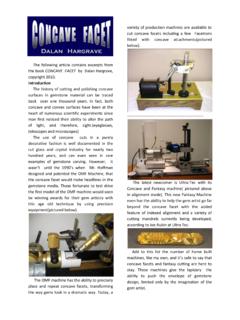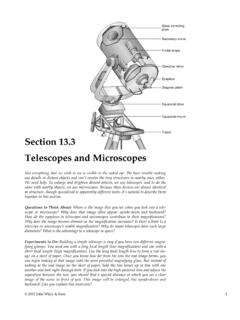Transcription of dbm do7 L 79. BOOKLET No. - mpsc.gov.in
1 Am-2E4~ dbm do7 L 79. < * -Cr?L 201 8 / - BOOKLET No. -. rr~* GI1 *s- aw 11 ~TFi:80 L d m/SPACE FOR ROUGH WORK WFlT& GllT I SPACE FOR ROUGH WORK Gll 4 Read the following passage and answer the questions from 1 to 5 : Adverse Impacts of Green Revolution There can be no doubt that the first Green Revolution lifted the country out of a situation immediately after independence when the prospects of famine and scarcity of food commodities loomed large. The rapidly expanding population could have made matters all the more worse. It was the Green Revolution that helped tackle the food security issue with increased agricultural productivity.
2 However, the Green Revolution did have some adverse impacts too which are being felt in the long run. Since the emphasis was mainly on cereals like rice and wheat, there was a loss of productivity as far as pulses, fruits and vegetables were concerned. The present rate of fruit and vegetable production will not be able to cope with the future demand as the population is increasing rapidly. Besides, production of the same type of cereals such as rice and wheat year after year gradually decreased soil fertility making it difficult for pulses and other vegetables to grow.
3 Monoculture (the cultivation of same crop variety for a prolonged period) also led to breakdown of the plant's resistance to pests and diseases which is an unwelcome offshoot of the first Green Revolution. Another criticism often directed at the first Green Revolution is the indiscriminate use of fertilizers and pesticides that is today threatening the agri-future of the country. Excessive and inappropriate use of fertilizers and pesticides led to widespread environmental damage polluting waterways, poisoning agricultural workers and killing beneficial insects and other wildlife.
4 The first Green Revolution also did not take care of certain areas like rainfed, hilly, coastal, dry land and arid zones which could be developed properly for production of exportable items like fruits, honey, mushroom, milk, meat, etc. Critics of the Green Revolution have also argued that owners of large farms were the main adopters of new technologies because of their better access to irrigation water, fertilizers, seeds and credit. Small farmers were either unaffected or harmed because the Green Revolution resulted in lower product prices, higher input prices and efforts by landlords to increase rent or force tenants off the land.
5 The Green Revolution also encouraged unnecessary mechanization, thereby pushing down rural wages and employment. Faulty irrigation practices also led to salt build-up and eventual abandonment of some of the best farming lands. Groundwater levels have retreated in areas where more water is being pumped for irrigation than can be replenished by the rains. Gl'Fll I SPACE FOR ROUGH WORK 1. ~~~*~dM;nift? Jr. *p* . Matm . ** 3. Tm&!t atm **: (1) mJrm* (2) m*&s (3) m 3T, F4 &3 (4) * Kd * The first Green Revolution did not take care of which of the following areas ?
6 A. Rainfed areas b. Coastal areas c. Fertile soil areas d. Arid areas Answer Options : (1) Onlyaandc (2) Only c and d (3) Only a, b and d (4) All of the above 2. GTr&wMI~M~**4? Jr. Tamml33lpv . * 3lpv . *,*eMh s. ~~~$aT~m **: Which of the following criticisms of the first Green Revolution islare correct ? a. Polluting waterways b. Polluting air c. Poisoning agricultural workers d. Killing beneficial insects and wildlife Answer Options : (1) Onlyaandb (2) Only c and d (3) Only b (4) Only a, c and d aWil?# WTI I SPACE FOR ROUGH WORK 3. clFfmM*mm~**a? ST.
7 *a~mm~~yr:~. 3. =lxQd, d*mihrm/mq.. =lxQd,damihrmmyr:. s. m;mt: (1) m a, q *s (2) wf3 7f, (3) mam7f, (4) *d* Which of the following statements idare correct about the Green Revolution ? a. There was emphasis mainly on cereals like rice and wheat. b. There was a loss of productivity of pulses, fruits and vegetables. c. There was emphasis mainly on pulses, fruits and vegetables cultivation. d. There was a gradual decrease in soil fertility year after year. Answer Options : (1) Only a, b and d (2) Only c (3) Only a and c (4) All of the above 4. -mM*m*&*&*?
8 ST. vl(lrH~41N** 3. *~~m s. WMrnd m*: (1) (2) m3mbr7f, (3) u;ifa ST, q *s (4) *d* Which of the following impacts on environment during the Green Revolution idare correct ? a. Faulty irrigation practices b. Increase of salt in soil c. Abandonment of some of the best farming lands d. Groundwater levels have retreated Answer Options : (1) Only a (3) Only a, b and d (2) Only b and c (4) All of the above aiECW mrm3fiift GllTI I SPACE FOR ROUGH WORK Which of the following adverse impacts of the Green Revolution idare correct ? a. Production of, same type of cereals year after year decreased soil fertility.)
9 B. Loss of soil fertility made it difficult for pulses and vegetables to grow. c. Monoculture led to breakdown of plant's resistance to pests and diseases. Answer Options : (1) Only a (2) Only a and b (3) Only a and c (4) All of the above VPTld TflTI I SPACE FOR ROUGH WORK WFfFd I SPACE FOR ROUGH WORK Read the following passage and answer the questions from 6 to 10 : 'Communication Technology' has been the single most important economic force shaping all societies over thk past half-century with geography; national borders and time zones becoming irrelevant with 'the new communication revolution'.
10 In today's changing world, global electronic commerce is growing so fast and creating new opportunities for trade that no country can afford to miss it. Such explosive innovations and developments in science and technology have deeply influenced the direction and trends in international trade. The role of international trade in the process of economic development is widely recognized. International trade brings a variety of static and dynamic gains and thus increases the capacity for development. Larger the volume of trade, greater is the potential for development.









